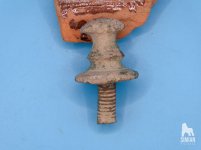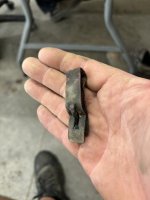http://cgi.ebay.com/SPANISH-GOLD-CO...goryZ547QQssPageNameZWDVWQQrdZ1QQcmdZViewItem
There are several problems with this coin but the most obvious is the weight at 6.8 grams with the bezel. The coin is clearly underweight and it most likely weighs in at 5 grams subtracting out the bezel weight, but it doesnt look cut down. The certificate is very suspicious. None of my friends who are coin experts have ever heard of the dealer who authenticated, but he may have been around in the 1970s. This coin if very puzzling, it appears to have coral in the groves of the cross and file lines in the periphery. I consulted a couple of experts who said the coin has issues. While I am not saying that it is a fake reproduction coin, it is very suspicious. This appears to be a very old bezel as well and the color of the gold looks bad but that could be the photo.
I just want to hear your opinion on this coin, I have mine and I would not touch it. If it were 24kt solid gold it might be worth 190- $200 in todays market, but I cant see someone bidding it up to $355. Please do not harrass the seller of the coin. There is no direct proof that it is a fake. I have asked the seller for edge scans and diameters but have yet to get answers or photos, he did say that he would take a return on it if it is not authentic. He may not know about the coin and I dont think there is any intent to defraud anyone so leave him be, he is a legitamite ebay seller with good feedback. Lets just keep this discussion on the page and go from there.
TNBob
There are several problems with this coin but the most obvious is the weight at 6.8 grams with the bezel. The coin is clearly underweight and it most likely weighs in at 5 grams subtracting out the bezel weight, but it doesnt look cut down. The certificate is very suspicious. None of my friends who are coin experts have ever heard of the dealer who authenticated, but he may have been around in the 1970s. This coin if very puzzling, it appears to have coral in the groves of the cross and file lines in the periphery. I consulted a couple of experts who said the coin has issues. While I am not saying that it is a fake reproduction coin, it is very suspicious. This appears to be a very old bezel as well and the color of the gold looks bad but that could be the photo.
I just want to hear your opinion on this coin, I have mine and I would not touch it. If it were 24kt solid gold it might be worth 190- $200 in todays market, but I cant see someone bidding it up to $355. Please do not harrass the seller of the coin. There is no direct proof that it is a fake. I have asked the seller for edge scans and diameters but have yet to get answers or photos, he did say that he would take a return on it if it is not authentic. He may not know about the coin and I dont think there is any intent to defraud anyone so leave him be, he is a legitamite ebay seller with good feedback. Lets just keep this discussion on the page and go from there.
TNBob







 It's one of the great wonders of our day that any had any detail left after cleaning.
It's one of the great wonders of our day that any had any detail left after cleaning.



